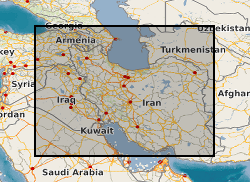Igneous rocks
Type of resources
Topics
Keywords
Contact for the resource
Provided by
Years
Formats
Representation types
Update frequencies
-

This dataset contains major element, trace element and isotopic analyses for samples collected during the NERC project "Orogenic Plateau Magmatism" (NE/H021620/1) (2011-2014). Samples are late Cenozoic volcanic rocks erupted across centres of the Iranian or Armenian sectors of the Turkish-Iranian Plateau, during the ongoing Arabia-Eurasia continental collision. Results have been published in the following papers: Allen, M.B., Kheirkhah, M., Neill, I., Emami, M.H. & McLeod, C.L. (2013) Generation of arc and within-plate chemical signatures in collision zone magmatism: Quaternary lavas from Kurdistan Province, Iran. Journal of Petrology, 54,887-911. Kheirkhah, K., Neill, I., Allen, M.B. & Ajdari, K. (2013) Small-volume melts of lithospheric mantle during continental collision: late Cenozoic lavas of Mahabad, NW Iran. Journal of Asian Earth Sciences, 74, 37-49. http://dx.doi.org/10.1016/j.jseaes.2013.06.002. Kheirkhah, K., Neill, I. & Allen, M.B. (2015) Petrogenesis of OIB-like basaltic volcanic rocks in a continental collision zone: Late Cenozoic magmatism of Eastern Iran. Journal of Asian Earth Sciences, 106, 19-33. Neill, I., Meliksetian, K., Allen, M.B., Navasardyan, G. & Kuiper, K. (2015) Petrogenesis of mafic collision zone magmatism: The Armenian sector of the Turkish-Iranian Plateau. Chemical Geology, 403, 24-41. Neill, I., Meliksetian, K., Allen, M.B., Navarsardyan, G. & Karapetyan, S. (2013) Pliocene-Quaternary volcanic rocks of NW Armenia: magmatism and lithospheric dynamics within an active orogenic plateau. Lithos, 180-181, 200-215.
-

Complete major and trace element analyses of all samples investigated under project component chalcophile element processing beneath arc volcanic systems, within NE/M000427/1 (see Cox et al., EPSL, 2019 https://doi.org/10.1016/j.epsl.2019.06.017 and Cox et al., Geology, 2020 https://doi.org/10.1130/G47562.1). Samples include an extensive dataset from Antuco volcano, Chile, and further analyses of young volcanic rocks from multiple Chilean stratovolcanoes and monogenetic centres. Standard data are also provided.
-

This dataset contains raw (clean but not interpreted) triaxial compressive strength data of tests conductive at elevated pressure and temperature as outlined in "Vannucchi, P., Clarke, A., de Montserrat, A., Ougier-Simonin, A., Aldega, L., & Morgan, J. P. (2022). A strength inversion origin for non-volcanic tremor. Nature Communications, 13(1), 2311. https://doi.org/10.1038/s41467-022-29944-8". The data is provided in a .zip folder containing the files of 5 experiments that are accompanied by a README file for introduction. Files format is Microsoft Excel Worksheet (.xlsx) and data are tabulated. Each file contains the corresponding relevant sample’s details, and each column of data is clearly labelled, units included. For each experiment, time, axial force, axial displacement, axial stress, confining displacement, confining pressure, axial strain A and B, axial average strain, circumferential extensometer, circumferential strain, volumetric strain, internal temperature, and axial delta P were recorded. Triaxial testing was undertaken using the MTS 815 servo-controlled stiff frame inside a vessel capable of a confining pressure up to 140 MPa at the Rock Mechanics and Physics Laboratory, British Geological Survey, UK. The confining cell is fitted with external heater bands and utilizing utilizes cascade control from internal and external thermocouples (accurate to ± 0.5°C). An initial axial pre-load of 2.3 kN was applied, to ensure a stable contact and alignment of the platens. The confining pressure vessel was then closed and filled with mineral oil confining fluid. The axial pre-load was maintained whilst the confining pressure was applied at 2 MPa/min to 60 or 120 MPa; these values were chosen to approximately bracket the pressures at the up-dip limit of seismic nucleation, corresponding to 2 – 4 km depth (Arroyo et al., 2014). At this point, whilst held in axial force and confining pressure control, the rig was heated at 2°C/min to 60°C to approximate the average temperature conditions at the depth of the up-dip limit of seismic nucleation (Harris and Spinelli, 2010). The samples were then left for approximately 1 hour allowing thermal equilibrium to be reached throughout the confining fluid and the samples. Once stable, axial loading was initiated in constant axial strain rate control at a rate of 5.0 x 10-6 s-1 until macroscopic failure occurred or a significant amount of post peak-stress axial strain was recorded (between 2% and 5%). We note that one test was conducted at the higher temperature of T=120°C with a result within 2.5% of the strength at T=60°C (Table 1). As this is below the expected sample-to-sample variability, no further temperature studies were conducted. The axial load, axial load actuator displacement, axial stress (s1), differential stress (Q=s1 - s3), confining pressure Pc (= s2= s3), confining pressure actuator displacement, axial strain (eax), circumferential strain (ecirc) and temperature were monitored throughout at sampling frequencies of 1s and 0.5kN. File names are: YYYY-MM-DD_LabProjectNumber_SiteName-SampleNumber
 NERC Data Catalogue Service
NERC Data Catalogue Service